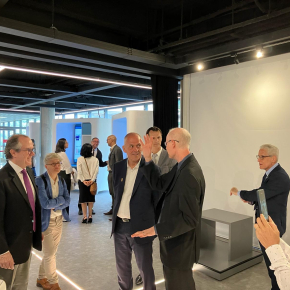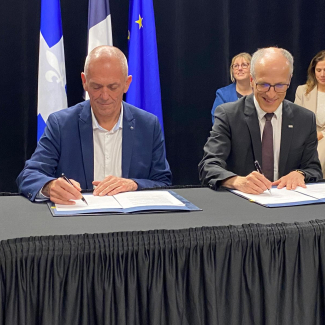
The CNRS has inaugurated the Maison du CNRS at the University of São Paulo
On Thursday March 27th, during the French President's visit to São Paulo, the CNRS inaugurated the Maison du CNRS on the campus of the 'Paulista' university. The new structure is to house the CNRS's South American Office from September of this year.
In the late afternoon with the Indian summer sun still shining down on Brazil, the Butantã campus at the Brazil's leading university, the University of São Paulo (USP) – the most populous city in both Brazil and the whole continent – was buzzing with activity. And with good reason. On Wednesday March 27th, the President of the French Republic Emmanuel Macron made a point of visiting the USP despite the busy schedule for his first state visit to Brazil. One notable reason for the visit was to inaugurate a new Institut Pasteur the thirty-third in the world. The São Paulo Institute is to be dedicated to biomedical research.
However the Institut Pasteur is not the only French institution with a presence in São Paulo. The USP, Latin America's leading university, attracts many such organisations but the CNRS occupies a central position among other long-established French institutions. After launching an international research centre1 (French link) (IRC) last year with the USP (its main partner in Brazil), the CNRS represented by Antoine Petit, its Chairman and CEO, has now inaugurated the Maison du CNRS.
In this 400m² space made available to the French organisation by its Brazilian counterpart, Antoine Petit recalls his 2023 visit to Carlos Carlotti Junior, the USP's rector. The latter offered him "a key and giving us a tour of what was then an empty space, sharing his vision of turning it into the Maison du CNRS for hosting scientific events that would shape our joint research efforts". At the inauguration ceremony, the heads of the two institutions signed three agreements. The first officialises the creation of a new international research laboratory2 – Immunology: Regulation of host responses and immune health3 , the second provides for the USP to host the CNRS office and the third signed by the CNRS, the São Paulo Research Foundation (FAPESP) and the USP sets out the support measures for French researchers assigned to joint laboratories run in partnership with the USP. The latter of the three is unique worldwide and authorises CNRS scientists to benefit from the financial mechanisms of the FAPESP, Brazil's main research support organisation.
Antoine Petit was particularly keen to highlight the success of the IRC after just one year of operation. "USP isn't just the top university in Latin America; it's a beacon of excellence in education and research, a defender of democracy in challenging times, and a valued partner in scientific collaboration worldwide and CNRS is very honored to be such a close partner of your prestigious University".
The IRC will intensify scientific cooperation
In fact, the presidential visit and the Maison du CNRS are both testimony to the USP's major place in the scientific ecosystem in Brazil – and, more broadly, in Latin America as a whole – and in its scientific links with France. With its 100,000 students the USP is a structuring stakeholder in South American research, accounting for a quarter of Brazil's scientific output, and is indeed considered the best university in South America Logically enough, it is also a resolutely international university with 45% of its research carried out in collaboration with at least one partner from another country.
Among the USP's international partners, France is ranked fourth and the CNRS is first among the partner scientific institutions ahead of Harvard and Michigan universities with nearly 3,000 scientific co-publications in 2023 – more than half of all French joint articles. These positive results can notably be explained by France's relationship of close to a century with the São Paulo State University which was modelled on the French academic model and founded in part by French scientists such as Claude Lévi-Strauss and Fernand Braudel.
This collaboration has intensified since the creation in 2023 of the international centre. At the centre's inauguration Alain Schuhl, the CNRS Deputy CEO for Science, explained that "given that Brazil invests heavily in research and possesses world-class infrastructures, it was only natural for the CNRS to continue to structure substantial collaboration initiatives there, particularly with Brazil's leading university". The CNRS and the USP already had well-established collaboration projects in the humanities, energy and the environment and therefore decided last year to expand and diversify their research fields in setting up a resolutely interdisciplinary IRC. As well as the fields that have already been mentioned, the new IRC will focus on the sciences of the universe, information technology, quantum technologies, biology and research into agriculture and decarbonisation.
The two parties initially worked jointly on the centre's construction phrase and now the time has come to take stock of the first results which are excellent. Several events in recent months or planned for the near future demonstrate the vitality of scientific exchanges between the two institutions. Last September, the 'World in Transitions' workshop in the humanities and social sciences was held in São Paulo. In October, the 'Techno-Human Systems of the Future' workshop (French link) in the computer sciences was held before the 'New Territories' symposium at the end of March in the ecological and environmental sciences. In parallel, the January 2024 launch of the Immune Health IRL located at the Ribeirão Preto Faculty of Medicine will be followed next autumn by the 'Worlds in Transition' IRL in the humanities and social sciences. Also two international research networks4 (IRN), three emerging international actions5 (IEA) and six international research projects6 (IRP) have been or will be added to the existing four IRPs run with the USP. In fact, all these joint structures with the USP mean the 'Paulista' university actually accounts for half of the CNRS's structuring cooperation schemes in Brazil.
The CNRS South American Office has moved to São Paulo
This local dynamism drove the CNRS's decision to move its South American office from Rio de Janeiro, where it has been located since 2010, to São Paulo's Maison du CNRS on September 1st of this year. The Maison du CNRS has been allotted a large space which means it will also be able to host a number of conferences in the same vein as the first three workshops. It will also host scientists visiting São Paulo or assigned to future IRLs. However, moving the office does not mean scientific relations with the Federal University of Rio de Janeiro (UFRJ) are to end. On the contrary, the UFRJ remains the CNRS's second-largest partner in Brazil just behind the USP, accounting for over 1200 joint publications between 2018 and 2022. Also the UFRJ still possesses numerous mechanisms for structuring cooperation with one research project and two international research networks to its credit. Also a new emerging international green chemistry initiative is set to be launched this year. Rio de Janeiro is also home to the first Franco-Brazilian IRL, namely the Jean Christophe Yoccoz / Instituto de Matematica Pura e Aplicada (French link) laboratory founded in 2005 to provide enhanced support for Franco-Brazilian cooperation in mathematics research.
Liviu Nicu, the director of the CNRS's South American Office and the IRC's Scientific and Operational Director, consider the move will change nothing as regards the office's work. "Whether we're in Rio de Janeiro, São Paulo, Santiago de Chile or Buenos Aires, our fundamental mission remains the same – to maintain scientific cooperation with our partners in South America".
- 1An IRC is a new institutional mechanism intended to establish an ambitious strategic dialogue between the CNRS and its academic partner. The aim is to define the partners' common interests and the collaboration projects required to work effectively on these. They can take the form of international research laboratories, research projects, thematic networks or other existing or future mechanisms.
- 2IRLs are international research facilities working on shared scientific themes. They provide structure for a significant presence of scientists from a limited number of research institutions from France and another country in a given location for a duration of five years.
- 3CNRS / University of Orléans / USP.
- 4The aim of an IRN is to structure an international scientific community to work together on a shared theme or research infrastructure. It promotes the organisation of international workshops, seminars or thematic schools organised by the network's partners in France and other countries. For its five year duration, it brings together researchers from one or more French laboratories (including at least one CNRS laboratory) and several partner laboratories in other countries.
- 5IEAs are 'PI-to-PI' projects whose objective is to explore new fields of research and international partnerships through short-term missions, organising working meetings and initial joint research work on a shared scientific theme. These actions last for two years.
- 6IRPs are collaborative research projects that involve one or more CNRS laboratories and laboratories in one or two other countries. They enable the consolidation of already established collaboration initiatives through short or medium-term scientific exchanges. Their purpose is to organise working meetings or seminars, develop joint research activities including field research, and also to supervise students. The teams from France and other countries need to have demonstrated they can work productively together, for example through one or more joint publications. IRPs run for five years.


